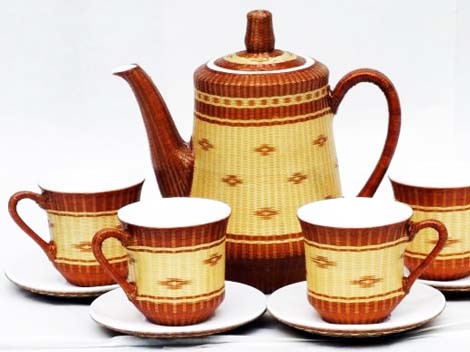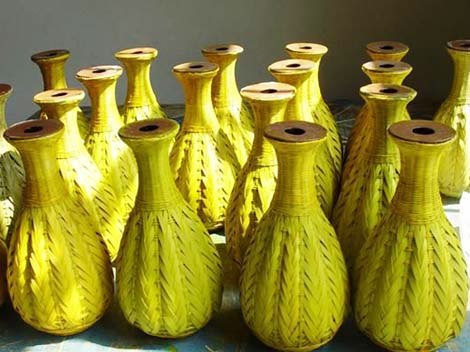Bamboo-Over-Porcelain Ware is a featured craftwork fabricated by weaving bamboo filaments over glittering and translucent porcelain. The most famous bamboo over porcelain is produced in Pingle Town, a renowned historic and cultural town in Chengdu City.

Chengdu bamboo over porcelain can be traced back to the late Qing Dynasty. Usual raw material for bamboo over porcelain is ci bamboo (sinocalamus affinis). It is processed into pliable bamboo filaments, which are used to weave outer wears of tailor-made porcelain ware such as tea sets, cups, trays and vases. In this way, porcelain ware can be protected against damages. Also, fragile porcelain ware and aleak bamboo container can offset weakness of and add radiance to one another. When fabricating bamboo over porcelain, the craftsman will hold the porcelain in his arms and carefully weave colorful bamboo filaments around it layer after layer. The long and smooth bamboo filaments will, like wool threads, be operated by fingers of the craftsman. They will undergo foundation laying, duplicating, tilting, opening locking and other working procedures. After that, an exquisite bamboo artwork will be completed. The craft for bamboo over porcelain is so exquisite, eminent and mature that joints of filaments are invisible. It is perceived by many people that such artwork is finished at a sitting with an extraordinarily long bamboo filament.


The Bamboo-Over-Porcelain Ware is a perfect combination of appreciation and practicality. Elegant and practical artwork of bamboo over porcelain is of diversity, ranging from mess tin, rice bowl and cigarette case in the Qing Dynasty to vase, sugar basin, caddy, tea covered-bowl and purse in modern times. What deserves to be mention is the skill of weaving various patterns around curved and exiguous teapot mouth and cup handle, which is incomparable by other bamboo weaving crafts.





